
Pope Adrian V, born Ottobuono de' Fieschi, was the head of the Catholic Church and ruler of the Papal States from 11 July 1276 to his death on 18 August 1276. He was an envoy of Pope Clement IV sent to England in May 1265 who successfully completed his task of resolving disputes between King Henry III of England and his barons. Adrian V was elected pope following the death of Innocent V, but died of natural illness before being ordained to the priesthood.
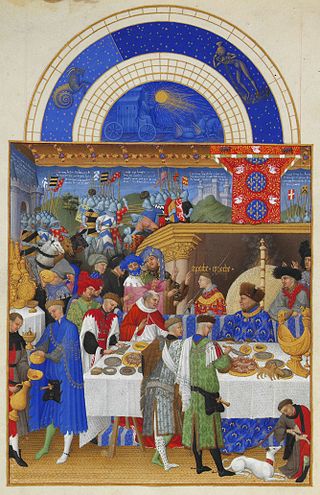
The Très Riches Heures du Duc de Berry, or Très Riches Heures, is the most famous and possibly the best surviving example of manuscript illumination in the late phase of the International Gothic style. It is a book of hours: a collection of prayers to be said at the canonical hours. It was created between c. 1412 and 1416 for the extravagant royal bibliophile and patron John, Duke of Berry, by the Limbourg brothers. When the three painters and their sponsor died in 1416, possibly victims of plague, the manuscript was left unfinished. It was further embellished in the 1440s by an anonymous painter, who many art historians believe was Barthélemy d'Eyck. In 1485–1489, it was brought to its present state by the painter Jean Colombe on behalf of the Duke of Savoy. Acquired by the Duc d'Aumale in 1856, the book is now MS 65 in the Musée Condé, Chantilly, France.

Charles William Dyson Perrins FRAS was an English businessman, bibliophile and philanthropist. He was born in Claines, near Worcester, the son of James Dyson Perrins, the owner of the Lea & Perrins Worcestershire sauce factory and the grandson of William Perrins, co-originator of the Lea & Perrins secret recipe.

The Luttrell Psalter is an illuminated psalter commissioned by Sir Geoffrey Luttrell (1276–1345), lord of the manor of Irnham in Lincolnshire, written and illustrated on parchment circa 1320–1340 in England by anonymous scribes and artists.

The Paris Psalter is a Byzantine illuminated manuscript, 38 x 26.5 cm in size, containing 449 folios and 14 full-page miniatures. The Paris Psalter is considered a key monument of the so-called Macedonian Renaissance, a 10th-century renewal of interest in classical art closely identified with the emperor Constantine VII Porphyrogenitus (909-959) and his immediate successors.
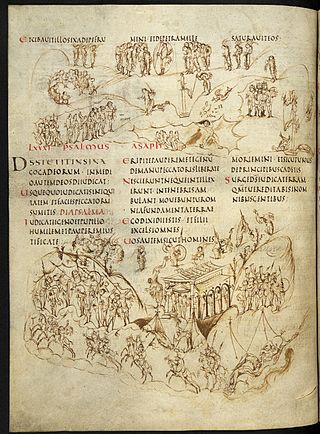
The Utrecht Psalter is a ninth-century illuminated psalter which is a key masterpiece of Carolingian art; it is probably the most valuable manuscript in the Netherlands. It is famous for its 166 lively pen illustrations, with one accompanying each psalm and the other texts in the manuscript. The precise purpose of these illustrations, and the extent of their dependence on earlier models, have been matters of art-historical controversy. The psalter spent the period between about 1000 to 1640 in England, where it had a profound influence on Anglo-Saxon art, giving rise to what is known as the "Utrecht style". It was copied at least three times in the Middle Ages. A complete facsimile edition of the psalter was made in 1875, and another in 1984 (Graz).

The Psalter of Oswald also called the Ramsey Psalter is an Anglo-Saxon illuminated psalter of the last quarter of the tenth century. Its script and decoration suggest that it was made at Winchester, but certain liturgical features have suggested that it was intended for use at the Benedictine monastery of Ramsey Abbey in Huntingdonshire, or for the personal use of Ramsey's founder St Oswald.

The British Library is a research library in London that is the national library of the United Kingdom. It is one of the largest libraries in the world. It is estimated to contain between 170 and 200 million items from many countries. As a legal deposit library, the British Library receives copies of all books produced in the United Kingdom and Ireland, including a significant proportion of overseas titles distributed in the UK. The Library is a non-departmental public body sponsored by the Department for Culture, Media and Sport.

The Hunterian Psalter is an illuminated manuscript of the 12th century. It was produced in England some time around 1170, and is considered a striking example of Romanesque book art. The work is part of the collection of the Glasgow University Library, cataloged as Sp Coll MS Hunter U.3.2 (229), which acquired the book in 1807. It derives its colloquial name, the "Hunterian Psalter", from having been part of the collection of 18th century Scottish anatomist and book collector William Hunter, who willed his collection to the University. It has also at times been known as the "York Psalter", owing to its supposed northern English origin in the city of York.
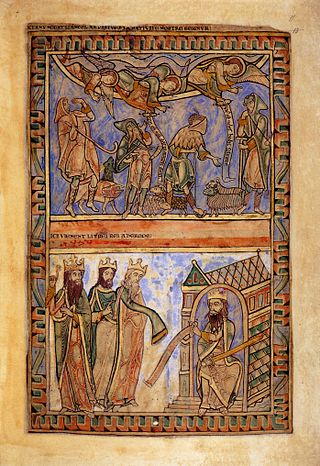
The Winchester Psalter is an English 12th-century illuminated manuscript psalter, also sometimes known as the Psalter of Henry of Blois, and formerly known as the St Swithun's Psalter. It was probably made for use in Winchester, most scholars agreeing that the most likely patron was the Henry of Blois, brother of Stephen, King of England, and Bishop of Winchester from 1129 until his death in 1171. Until recent decades it was "a little-studied masterpiece of English Romanesque painting", but it has been the subject of several recent studies.

Two lavishly illustrated illuminated manuscript psalters are known as the Psalter of Saint Louis as they belonged to the canonized King Louis IX of France. They are now in Paris and Leiden, and are respectively good examples of French Gothic and English Romanesque illumination.

The Eadwine Psalter or Eadwin Psalter is a heavily illuminated 12th-century psalter named after the scribe Eadwine, a monk of Christ Church, Canterbury, who was perhaps the "project manager" for the large and exceptional book. The manuscript belongs to Trinity College, Cambridge and is kept in the Wren Library. It contains the Book of Psalms in three languages: three versions in Latin, with Old English and Anglo-Norman translations, and has been called the most ambitious manuscript produced in England in the twelfth century. As far as the images are concerned, most of the book is an adapted copy, using a more contemporary style, of the Carolingian Utrecht Psalter, which was at Canterbury for a period in the Middle Ages. There is also a very famous full-page miniature showing Eadwine at work, which is highly unusual and possibly a self-portrait.

The Queen Mary Psalter is a fourteenth-century English psalter named after Mary I of England, who gained possession of it in 1553. The psalter is noted for its beauty and the lavishness of its illustration, and has been called "one of the most extensively illustrated psalters ever produced in Western Europe" and "one of the choicest treasures of the magnificent collection of illuminated MSS. in the British Museum".

Galvano da Levanto or Galvanus de Levanto was a Genoese physician and writer. Devoutly religious, he may have joined the Third Order of Saint Francis. Having suffered medical and financial problems, he sought the patronage of King Philip IV of France and later Pope Boniface VIII and the Curia romana. He wrote prolifically on medical and theological topics, but his most famous work today is his crusade treatise.

The Westminster Psalter, British Library, MS Royal 2 A XXII, is an English illuminated psalter of about 1200, with some extra sheets with tinted drawings added around 1250. It is the oldest surviving psalter used at Westminster Abbey, and is presumed to have left Westminster after the Dissolution of the Monasteries. It joined the Old Royal Library as part of the collection of John Theyer, bought by Charles II of England in 1678. Both campaigns of decoration, both the illuminations of the original and the interpolated full-page drawings, are important examples of English manuscript painting from their respective periods.

The Gorleston Psalter is a 14th-century manuscript notable for containing early music instruction and for its humorous marginalia. It is named for the town of Gorleston in Norfolk.
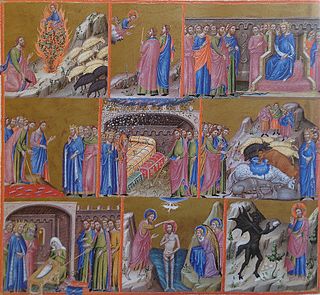
The Great Canterbury Psalter is an early 13th- and mid 14th-century illuminated manuscript with the shelfmark MS lat. 8846 in the Bibliothèque nationale de France in Paris. It was made in two different locations and moments in time: at Canterbury around 1200 and in Catalonia around 1340. It is the last of a series of copies of the Utrecht Psalter made in Canterbury, following the Harley Psalter and the Eadwine Psalter.

The Tiberius Psalter is one of at least four surviving Gallican psalters produced at New Minster, Winchester in the years around the Norman conquest of England. The manuscript can now be seen in full online at the British Library website.
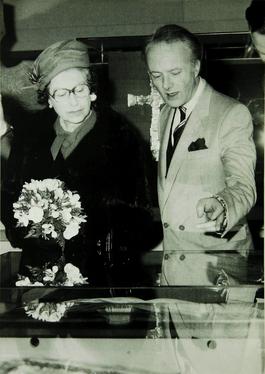
Derek Howard Turner was an English museum curator and art historian who specialised in liturgical studies and illuminated manuscripts. He worked at the British Museum and the British Library from 1956 until his death, focusing on exhibitions, scholarship, and loans.
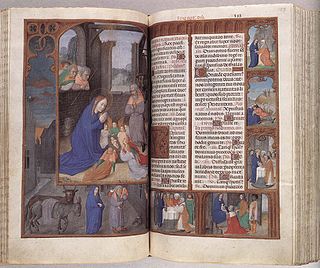
The Mayer van den Bergh Breviary is a 16th-century illuminated manuscript, a breviary, currently in the collections of Museum Mayer van den Bergh in Antwerp.




















